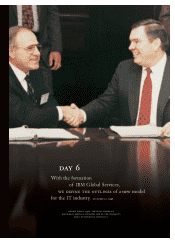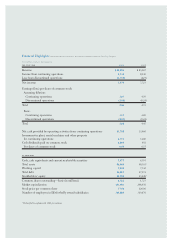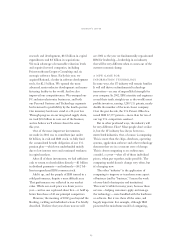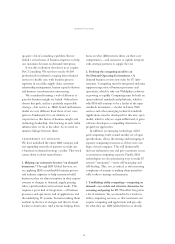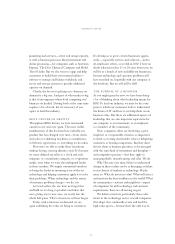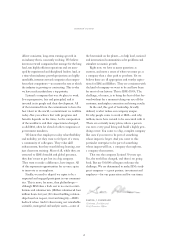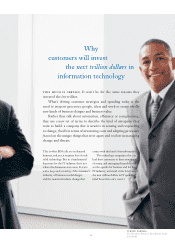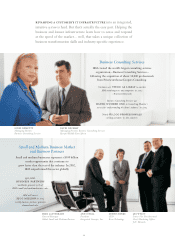IBM 2002 Annual Report Download - page 18
Download and view the complete annual report
Please find page 18 of the 2002 IBM annual report below. You can navigate through the pages in the report by either clicking on the pages listed below, or by using the keyword search tool below to find specific information within the annual report.
16
up quite a bit of consulting capability. But we
lacked a critical mass of business expertise to help
our customers become on demand enterprises.
It was this realization that drove us to acquire
PwC Consulting. We now have nearly 60,000
professionals in industries ranging from financial
services to health care, with business process
expertise in areas like supply chain, customer
relationship management, human capital solutions
and business transformation outsourcing.
We considered forming a web of alliances to
gain the business insight we lacked. Others have
chosen this path, and it’s a perfectly respectable
strategy—but not for us. IBM’s brand and business
model are very different from those of our com-
petitors. Fundamental to our identity as a
corporation is this fusion of business insight and
technology leadership. Our learning in each realm
informs what we do in the other. So we need an
intimate linkage between them.
leadership on demand
We have mobilized the entire IBM company and
our expanding network of partners to make our
e-business on demand strategy a reality. That work
comes down to three main thrusts:
1. Helping our customers become “on demand
businesses.” Through IBM Global Services, we
are applying IBM’s considerable business process
and industry expertise to help customers build
businesses that are almost intuitive in their respon-
siveness to changes in demand, supply, pricing,
labor, capital markets and customer needs. This
requires a great deal of integration—of business
processes and operations, and of applications and
the underlying IT systems. It means making them
resilient in the face of changes and threats, from
hackers to hurricanes. And it means helping them
focus on what differentiates them, on their core
competencies—and outsource or tightly integrate
with strategic partners to supply the rest.
2. Evolving the computing model to an
On Demand Operating Environment. On
demand business creates new rules for IT infra-
structure. Computing must be integrated and must
support integration of business processes and
operations, which is why our WebSphere software
is growing so rapidly. Computing must be built on
open technical standards and platforms, which is
why IBM will continue to be a leader of the open
standards movement—a leader in Linux, Web
services and other emerging technical standards.
Applications must be developed for this new, open
model, which is why we acquired Rational; it gives
software developers a compelling alternative to
proprietary approaches.
In addition, an emerging technology called
grid computing, built around another set of open
specifications, allows the sharing and managing of
separate computing resources as if they were one
huge, virtual computer. This will dramatically
increase utilization rates and give customers access
to enormous computing capacity. Finally, IBM
technologists are also pioneering ways to make IT
systems “autonomic”—more self-managing and
self-healing. This, too, is critical, as the increasing
complexity of systems is making them unrealisti-
cally costly to manage and maintain.
3. Establishing utility computing—computing on
demand—as a viable and attractive alternative for
accessing and paying for IT. This effort has gotten
a lot of attention. Yes, we intend to be a leader in
utility computing services, so that customers can
acquire computing and applications and pay only
for what they use. IBM Global Services is already
chairman’s letter



